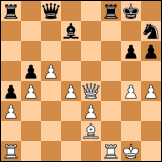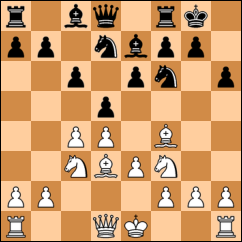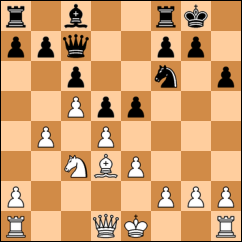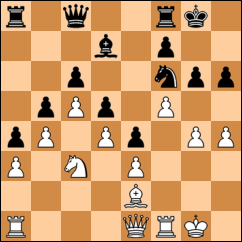Route 20 Chess Club
Freeport, Illinois, May 11, 2010
1.d4 Nf6 2.c4 e6 3.Nc3 d5 4.Bg5
When Gary and I postmortemed this game, I thought this move was a mistake on my part, because the game transposed into a Semi-Slav, in which white doesn't play the bishop move. But at this point, it's just the Cambridge Springs variation of the Queen's Gambit Declined, and I'm doing fine so far. Except that I don't really know the Cambridge Springs.
4...Nbd7 5.e3 c6 6.Nf3 Be7
Instead of the more standard move, 6...Qa5.
7.Bd3 h6 8.Bf4!? 0-0
This concludes our opening. I have a slight edge.
At this point, I have three almost equal choices: 9.Nd2, 9.cxd5 and 9.Ne5.
9.Ne5 Nxe5 10.Bxe5 Bd6 11.Bxd6
Not my best move. I'm thinking that I may as well take the opportunity to trade away Gary's good bishop. But my "bad" bishop is already outside my pawn chain and active, and trading helps him develop his queen, while if I just sit tight and let him initiate the trade, I retake with tempo. 11.Qe2, clearing white's back rank, retains the edge.
11...Qxd6 12.c5 Qc7 13.b4
I've forgotten about the center. 13.f4 is necessary to suppress the ...e5 push.
13...e5
The game is starting to swing Gary's way, and I can feel it. Like it or not, the center is about to get cracked open. My king is suddenly looking very exposed. Castling isn't a really attractive option, since Gary's queen and bishop are staring menacingly down at my kingside, but what other choice do I have, besides wishing I'd played 11.Qe2 so that I could castle queenside now? In fact, I have several choices, 14.Qd2 being the best, and the counterintuitive (to me, anyway) 14.dxe5 coming in second. Alas, I give in to my emotions.
14.0-0 e4 15.Be2 Bd7 16.f4
Corking the queen's diagonal and daring Gary to capture en passant, opening my rook's file.
16...b5
"The villainy you teach me, I will execute."
17.h4
Wrong side. Better is 17.a4 a6 18.f5.
17...a5 18.a3 a4 19.g4!? Qc8 20.f5 g6 21.Qe1!
Considerably more subtle than I'm usually capable of. Gary found it frustrating. This one little adjustment takes much of the steam out of the attack he's been preparing. As for me, I'm just looking for a way to get my queen out of the backfield.
21...Nh7 22.Qg3 Kh8?
 It's important for black to exchange pawns first (22...gxf5 23.gxf5+ Kh8), but I guess Gary didn't like the look of the discovered check. Neglecting the exchange leaves him open to the nasty sequence 23.fxg6 fxg6 24.Qe5+ Kg8 25.Nxd5 cxd5 26.Qxd5+ Kg7 27.Qe5+ Kg8 28.Qxe4 (diagram).
It's important for black to exchange pawns first (22...gxf5 23.gxf5+ Kh8), but I guess Gary didn't like the look of the discovered check. Neglecting the exchange leaves him open to the nasty sequence 23.fxg6 fxg6 24.Qe5+ Kg8 25.Nxd5 cxd5 26.Qxd5+ Kg7 27.Qe5+ Kg8 28.Qxe4 (diagram).Unfortunately, I missed it too.
23.h5??
Instead of exploiting Gary's error, I weaken my own position.
23...gxf5 24.gxf5??
Even worse -- I'm opening myself up to a pin on my queen! Evacuation is essential: 24.Qd6 Qb8 25.Qxb8 Raxb8 26.gxf5 Rg8+ 27.Kh2 limits the damage.
24...Rg8 25.Bg4
My best defense. What's Gary's best reply? (Highlight to reveal answer.)
25...Bxf5! 26.Qe5+ f6 27.Qxf5 Qxf5 (black can put a quick end to white's hopes with 27...Rxg4+!) 28.Rxf5 Rxg4+ 29.Kf2 Rag8 30.Rh1 Rg2+ 31.Kf1 Rc2 32.Ne2 Ra2 33.Nf4 Ra1+ 34.Kf2 Rxh1 35.Ng6+ Kg7 36.Ne7 Rh2+ 37.Kg3 Ra2 38.Nxc6 Rxa3 39.Kf4 Ng5 40.Ne7 Nh3+ 41.Kg4 Kf7+ 42.Kxh3?? (42.Nxg8 Kxg8 43.Kxh3) Rxe3+ 43.Kh4 Kxe7 0-1








0 comments:
Post a Comment